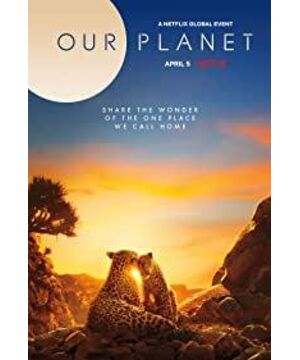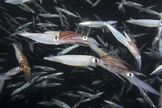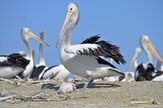l Introduction
Netflix announced that it has reached a partnership with Silverback, the producer of the BBC's award-winning nature documentary "Planet Earth", to create an 8-episode nature documentary of the same type "Our Planet" in 4K. Shoot in ultra-definition format. Netflix plans to broadcast this carefully crafted nature documentary about the earth to viewers in 2019.
The production staff of this documentary has received the cooperation of WWF, and will assist it in filming in various nature reserves. From the vast ice sheet to the depths of the ocean, from remote forests to the Gobi Desert, the documentary will document the world. The rarest animals go deep into every aspect of the rare nature reserve.
This documentary will explore the unique and precious miracles of the natural world, created by the creators of the award-winning drama "Pulsation of the Earth". Through cooperation with the World Wide Fund for Nature, "Our Planet" uses amazing photography and technology, and explores the surviving wild areas on the earth and the animal inhabitants in an unprecedented way of shooting. This 4-year big production show has been filmed in 50 countries/regions on all continents around the world. More than 600 staff members spent a total of more than 3,500 filming days, ranging from remote Arctic wilderness and mysterious deep seas to vast expanses. The landforms of Africa and the diversified tropical rain forests of South America pay full attention to the breadth of the diversity of habitats around the world.
l Notes
Episode 1 One Planet
In the past 50 years, the number of wild animals has fallen by an average of 60%. For the first time in human history, natural stability is no longer taken for granted.
In the past 70 years, the polar regions have warmed faster than any other place on the planet. The Arctic is a frozen ocean, and the sea ice on which all life depends is disappearing.
On our entire planet, important connections are being destroyed, and the long-term stability of us and all other life is being lost.
·African wild dog hunting wildebeest
·Red-capped Flycatcher and Blue Flycatcher courtship dance
·Flamingo
·Wolves hunt reindeer
·Polar bear
Episode 2 Frozen Worlds (Frozen Worlds)
Only the polar bears are strolling leisurely in the silent snow.
In the far Antarctic, there are penguins, walruses, seals, polar bears, and rare narwhals, where there is a diversity of species.
However, as the largest carnivore on land, the survival of polar bears is getting harder and harder. Because of the thinning of sea ice, they cannot hide on the open sea ice level and it is difficult to hunt successfully.
On the east coast of Russia, more than 100,000 walruses gather on a beach because they have no choice. The original home of the walrus was on sea ice, but the ice surface has now degraded to the north. In order to prey, they can only stay here. The crowded living environment makes trampling and injuries inevitable. In order to find enough habitat, some walruses had to climb the 80-meter-high cliff.
·Antarctica Gentoo Penguin
·Humpback Whale Krill
·Orcas prey on penguins
·Wandering albatross chicks in South George Islands
·Leopard seals and elephant-nosed seals prey on emperor penguins
·Polar bears prey on ringed seals
·The crowded walrus group
Episode 3 Tropical Rainforest (Jungles)
Has a treasure house of species diversity-the rain forest.
Although only 7% of the earth’s land area, rain forests are vital to the health of the earth. How many creatures there are here is still unknown. Over the past 20 years, the number of gorillas and wild elephant herds in the Congo rainforest has plummeted due to poaching.
In the past few years, the lowland rainforest that orangutans depend on has been reduced by an astonishing 75%. Looking at the world, we are losing rainforest at a rate of about 15 million hectares per year. What disappeared with it was the treasure house of diversity on this planet.
Rainforest can collect more carbon than other habitats on land, lower the temperature of the earth, and provide food and medicine. We will bear the consequences if we lose them.
·Congo rainforest lowland gorilla jungle elephant
·Western Six-line Bird of Paradise, New Guinea
·Borneo Rainforest Velvet Worm
·The relationship between carnivorous plants and tree shrews and ants
·Colorful bats spend the night in Nepenthes helmlis
·Philippine Eagle
·Leaf-cutting ants
·Brown-headed spider monkey South American animals and salted land
·Sumatran orangutans use tools to feed on ants
Episode 4 Coastal Seas
The coastal areas are rich in diverse species, which can provide sufficient food for wild animals and humans.
It is very important for coastal areas to respond to climate change. Seagrass absorbs 35 times as much carbon dioxide as rain forests in the same area, which reduces the damage caused by ocean warming.
While coastal areas are making indispensable efforts for the stability of the earth's environment, human behavior is causing devastating damage to it. Carbon dioxide causes global warming and also increases the acidity of seawater. No coral reef can survive these two changes.
In the boundless blue sea, whales can't swim to the end.
· Florida Everglades Stingray Dolphin
·Mangrove Coral Reef
·French Polynesian black-tailed red shark, shovel head, grey trident, night hunting
· California giant kelp submarine forest sea otters and beautiful stalactites eat sea urchins
·Alaska, Steller, sea lion, bald eagle, humpback whale, prey on migratory herring
·Luo Jinpan jellyfish
· Atacama Peruvian cormorants on the Pacific coast of South America, pelican, boobies, and sea lions prey on anchovies
·Manta ray cleft-lipped fish in the shark breeding grounds of Lai Sur Raja Ampat Islands
Episode 5 From Deserts to Grasslands
On the earth, one fifth of the land is covered by deserts. The driest is the Atacama in South America, where there has never been rain. The seemingly barren and ruthless desert is still closely related to life.
In Namibia, the oldest desert, there are already less than 100 desert elephants. Due to lack of water, they can only travel endlessly. The survival skills that have been passed down from generation to generation have gradually lost their usefulness in the face of a rapidly changing climate.
Ninety percent of the grassland disappeared, and most of it was used for agriculture. What we eat and how we produce will determine the future grasslands of our planet.
·Cheetah hunting wildebeest
·The Arabian Desert Soktra Cormorant Breeding
· Leopard Arabian Leopard Mating
·Arab sword antelope in the Rub Khali desert
·Namibian desert elephant desert lion
·Bison battle
·Hungarian steppe blue butterfly ants
·Mongolian high-nosed antelope Przewalski's wild horse
·Indian High Prairie Tabby Deer etc.
Episode 6 The High Seas
The ocean covers two-thirds of the world's area, and it's only the surface, it's also bottomless at the same time. The average depth of the ocean is 4 kilometers, and the deepest point can reach 10 kilometers.
Deep-sea creatures grow very slowly. Deep-sea fishing nets can destroy coral reefs that have been formed over centuries. So far, half of the deep-sea coral reefs have disappeared.
Decades of uncontrolled fishing behaviors have drastically reduced most of the fish resources, and one-third has already collapsed. If we continue to plunder ocean resources in this way, the entire ocean system will die out.
·Pseudo killer whale hunts dolphins, blue whale mother and child, spinning dolphins and yellowfin tuna prey on lantern fish
· Phytoplankton
·Deep-sea creatures, emperor hairtail, anglerfish, submarine silver shark, deep-sea coral reef, trident shark, caterpillar
·Giant owl, black-browed albatross, wandering albatross, yellow webbed ocean petrel, pecking at floating corpses in the ocean
·Bluefin tuna prey on anchovies
·Squid replace fish
Episode 7 Fresh Water
Fresh water is an indispensable element for the survival of all animals and plants on land. Most of the fresh water on the planet is hidden, and nearly two-thirds of it is frozen in the polar regions.
Two thirds of the rivers on the earth have been changed by our natural flow, mainly through the construction of dams. Therefore, many rivers around the world are no longer flowing, and more and more wild animals cannot get enough water.
Due to the increase in water consumption by human industry, the rivers with abundant water have dried up. Hippos that rely on flowing water to cool down can only be soaked in mud, and their living environment is deteriorating. With global warming, droughts in Africa have become more frequent and severe, and animals are facing great threats.
Not only do we need water, but animals also need it.
·Kingfisher prey
·Pelican of Lake Eyre, Central Australia
·Duck and brown bear prey on salmon
·Columbia Rainbow River
·Florida Otter Manatee Mayfly Kingfisher Owl Iguazu Falls
· Pantanal jaguar tries to catch capybara and crocodile
·Mekong Betta
·Lake Tanganyika Cichlids
·Ruaha Elephant Hippopotamus Lion Buffalo
·Platt River Sandhill Crane
Episode 8 Forests
Globally, we have destroyed more than half of the forests that once thrived on this planet. Not only are we losing the animals that once lived in them, we are also changing the global climate.
As long as the forests are given time, they will re-cover the entire earth, accompanied by diverse flora and fauna. A future with more forests is the key to our planet's resilience.
In the northern Taiga, there is an extremely rare and mythical animal-the Siberian tiger. There are fewer than 600 in the world.
Poaching has made Siberian tigers on the brink of extinction, and their survival must depend on the vast forests in the future.
·Siberian tiger wild boar in the southern northern forest
·Battle of Bald Eagles
·Sequoia forest rough moraine
·Lion-tailed monkey and double-horned hornbill fighting in the Western Ghats
·Miopau, Africa's largest forest elephant, cola bean wood caterpillar, African wild dog
·Madagascar Baobab lemur Falkland civet mating leaf worm squirrel lemur
·The restoration of Chernobyl Kestrel Przewalski's Mustang etc.
l Short comment
Fifty years ago, mankind successfully landed on the moon, which is a symbol of a big step forward in human history. In the other quadrant, they are declining rapidly-in the past 50 years, the number of wild animals has fallen sharply by 60%. While we are opening up the universe, we are destroying our own planet. The inadvertent actions of human beings will trigger the butterfly effect and cause huge disasters to animals on the other side of the earth.
On our planet, 100 orangutans die every week due to human activities. Their survival depends largely on its familiarity with this jungle landscape, so once the forest is destroyed, it will greatly threaten the survival of the orangutan.
In northern Russia, more than 100,000 walruses can only rest on land due to the rising temperature and melting glaciers.
Sharks eat big fish, and big fish eat small fish. Because of the hunting of sharks in large numbers, the number of big fish increased and the small fishes decreased, so the coral reefs lacked their cleaners. Coupled with global warming, the colorful coral reefs have died and bleached. Many marine organisms depend on coral reefs for survival, and half of the shallow coral reefs in the world have now disappeared.
The destruction of the ocean by plastic pollution is worrying, but in fact, what is more deadly to marine life is overfishing.
Nature’s self-repair ability is very strong, and within ten years it can restore the precarious marine ecology due to fishing. As long as we keep our eyes on the long-term, through protected seas, in the long run, our fishermen can spend less effort and catch more fish.
This is the resilience of our planet. But this requires human beings to control their temperament.
There have been many mass extinctions in history, and the earth is still shining with vitality. We protect nature not for our human homeland, but for human beings and our memories of all the good things on this planet. As mentioned in the film: "What we do in the next 20 years will determine the future of all life on earth."
View more about Our Planet reviews








